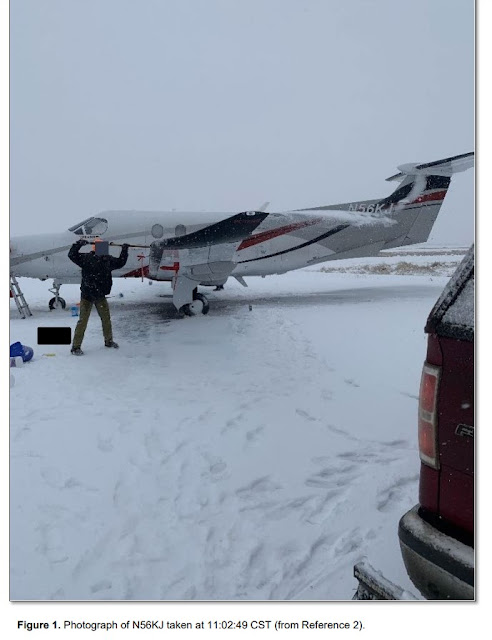The following information reveals the activation of the stick shaker at takeoff, the repeated automated "stall" announcements, and ultimately the stick pusher intervention, was an altered response because of changes to airspeed and AoA parameters made by the aircraft's Icing Protection System.
Reading the aircraft performance study produced by the NTSB provides details about "STICK PUSHER ICE MODE", which, when enabled, changes the engagement parameters of the sticker shaker and pusher. In addition, when the system is active, the AoA sensors reset system datum by altering the critical angle of attack values by minus 8 degrees and resultant changes to critical aircraft speeds. The following is presented in the NTSB Aircraft Performance Study:
The propeller heat ON and inertial separator door OPEN settings indicate that the airplane was in “STICK PUSHER ICE MODE” during the takeoff. As described in the AFM:
When the propeller de-ice is selected to ON and the inertial separator selected to OPEN, the stall protection system, stick pusher/shaker system is re-datumed to provide both shake and push functions at lower angles of attack and higher speeds.
This is to protect against the natural stall through the effects of residual ice on the protected surfaces of the airfoil leading edges. When the system is in the re-datum
mode, the aircrew are alerted by illumination of the green ICE PROTECTION caption PUSHER ICE MODE. Failure of the system in ice mode will result in the caption being extinguished and the amber CAS caption Pusher will be illuminated and an aural gong will sound.
When operating in STICK PUSHER ICE MODE, the stick pusher computer automatically reduces the shaker and pusher settings as measured by the angle of attack vanes, by 8°. With operational pneumatic de-ice boots, this results in an increase of the stall speed at the maximum takeoff weight of 12 kts with
flaps set to 0° and 9 kts with flaps set to 15°. In addition, the AFM indicates that when the PUSHER ICE MODE is active, some operational airspeeds must be modified, as shown in Table 3:
PUSHER ICE MODE OFF
Takeoff rotation speed:
82 KIAS flaps 15
76 KIAS flaps 30
PUSHER ICE MODE ON
92 KIAS flaps 15
Speed at 50 ft:
PUSHER ICE MODE OFF
(Flaps to 0 above 100 KIAS)
PUSHER ICE MODE ON
113 KIAS flaps 15
Best rate of climb @ sea level, flaps up:
PUSHER ICE MODE OFF
130 KIAS
PUSHER ICE MODE ON
135 KIAS recommended
Flaps 15 approach speed:
PUSHER ICE MODE OFF
99 KIAS
PUSHER ICE MODE ON
105 KIAS
Balked landing (Go-Around):
PUSHER ICE MODE OFF
98 KIAS flaps 15, gear down
89 KIAS flaps 30, gear down
85 KIAS flaps 40, gear down
PUSHER ICE MODE ON
105 KIAS, flaps 15, gear down
(Max flap 15° with residual ice)
Stall speed (pusher activation) at
maximum takeoff weight:
PUSHER ICE MODE OFF
95 KIAS flaps 0
78 KIAS flaps 15
PUSHER ICE MODE ON
107 KIAS flaps 0
87 KIAS flaps 15
Effect of PUSHER ICE MODE on operational airspeeds (data compiled from the PC-12/47E AFM):
Significantly, the AFM notes that when the PUSHER ICE MODE is on, the rotation speed must be increased by 10 knots, from 82 to 92 KIAS, at flaps 15 and the maximum takeoff weight.
The accident aircraft was equipped with an L3Harris Technologies Lightweight Data Recorder. This device captures both cockpit conversation and radio transmissions, while also recording FDR parameters.
Thread posts above provide details of disturbing cockpit audio, but there was no verbalization of a checklist. No mention was made regarding the engagement of the Icing Protection System, modified stall protection parameters, and changed aircraft takeoff and flight speeds.
The pilot rotated the aircraft at 88 kts, instead of the AFM published value of 92 kts. He also overrotated, blowing through the normal three or four degree range, and during the remainder of roughly thirty seconds before the aircraft crashed, he repeatedly used rapid pitch inputs that further reduced the airspeed and ultimately exceeded the critical angle of attack.
During the rotation, increased at a rate of about 7 °/s, reaching about 12° at 12:32:28.5, where it lingered for about half a second before continuing to increase (see Figure 12). reached 15°.at 12:32:30.8 and 15.8° at 12:32:32.5 before decreasing steadily to 9.8° at 12:32:37. However, thereafter started a series of oscillations that increased in amplitude and absolute value (reaching a peak of 21° at 12:32:49.6) before starting a sudden drop at 12:32:52.3, decreasing from 19° to -24° at the end of the data at 12:32:59.8.
I suspect the pilot was completely unfamiliar with the actions of the Ice Protection System and modified aircraft speeds present in the AFM.
All of this occurred in IMC. It was snowing, and the aircraft disappeared into the overcast seconds after liftoff.

